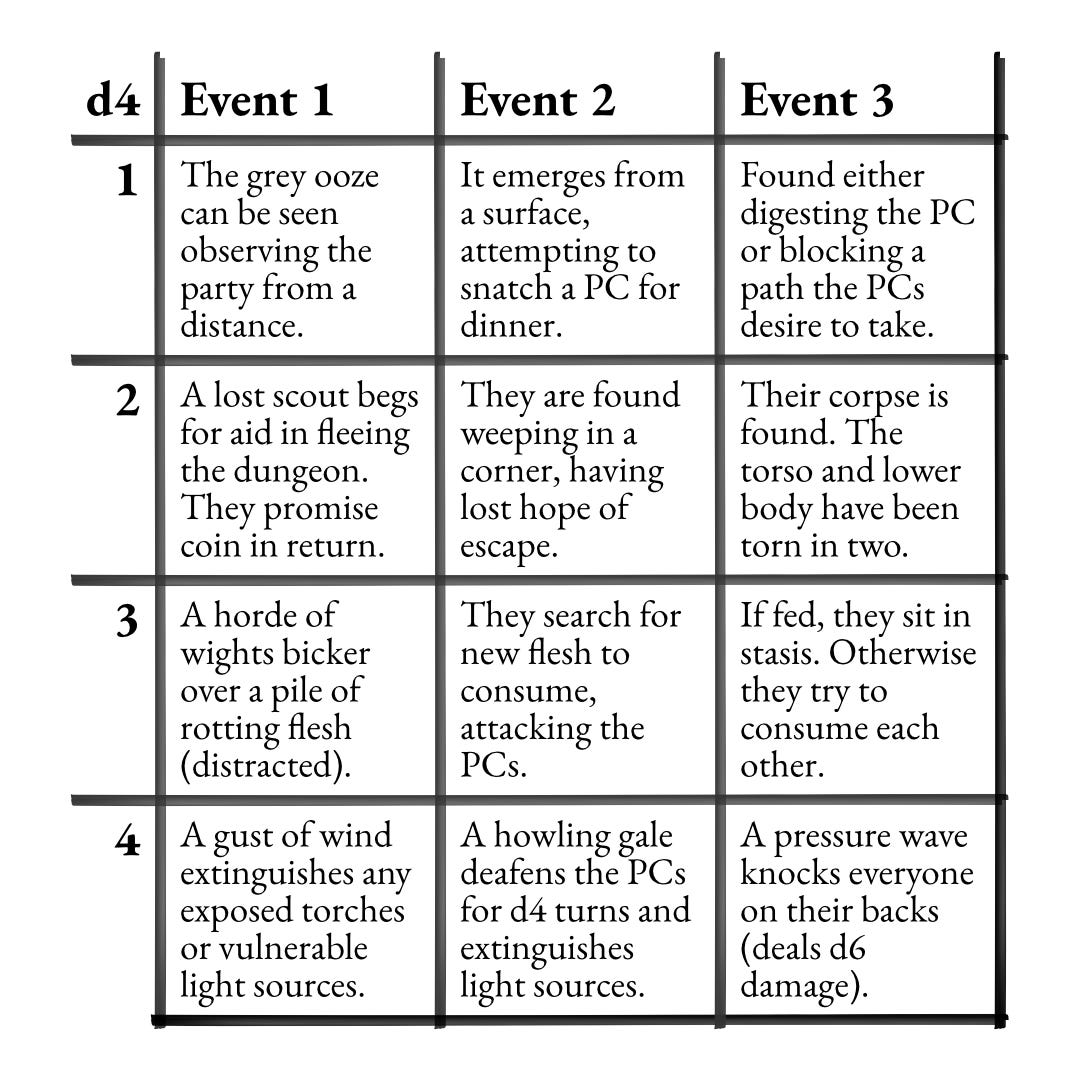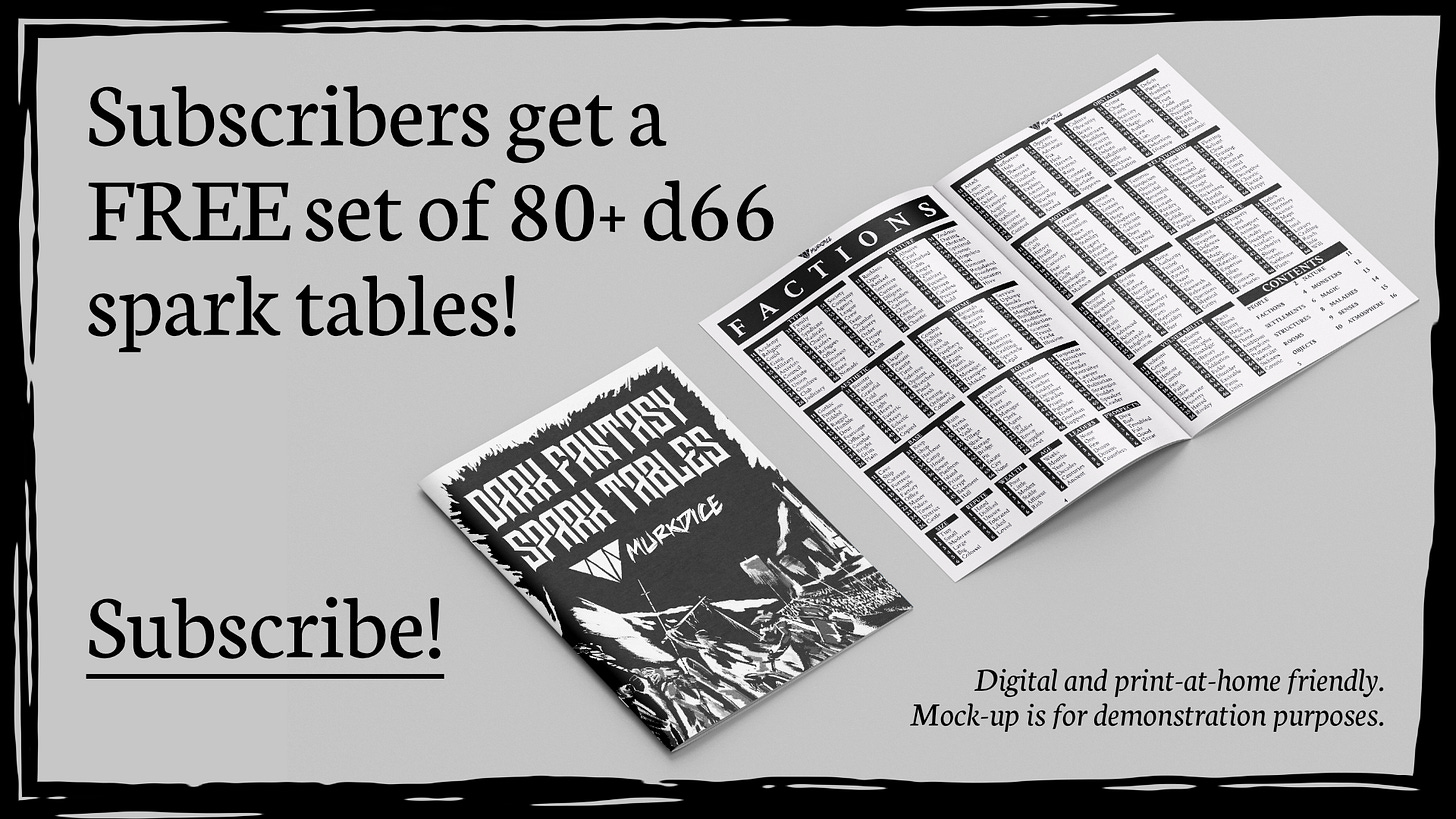Encounter tables that remember
The power of nested tables
This article contains affiliate links, meaning I get a commission if you make purchases using these links, at no cost to you.Encounter tables have a bit of an issue, to my mind anyway. Either:
The encounters entries are brief enough (e.g. 2d6 undead) that they can be used multiple times, but they are exactly that… brief. Which means no instantly complex situations to deploy at the table.
The encounters are complex situations, but that means they are hard to reuse.
This is for those of us who want those more complex encounters. How do we solve the issue of them running out?
One answer is to refill encounters as they get used up. This is great if we are making our own content, but it requires upkeep.
Another answer is to just make a big encounter table. Worried your d6 encounters won’t last the adventure? Make a d12 table instead. But that requires you to come up with many more new ideas.
I haven’t come up with a solution (super helpful, I know). But thinking about this problem led me to an idea I think is interesting. It looks like other folks have danced with this as well, which is a sign it has merit!
Nested tables
Let’s take a look at the table below, then dig into the idea.
This is a random encounter table, but one where each row has a sequence of events.
When you roll an entry for the first time, you use event 1.
If you re-roll an entry and if the next event is possible, you use that one.
If the next event isn’t possible, you use it to inspire a new encounter, or skip to the next one, if that’s plausible instead.
Why would we use this?
We can create more complex encounters as evolutions of existing ones, rather than having to come up with something completely new. This saves us the energy of creating entirely new ideas.
We can make encounters more dynamic and simulationist, and bring our level design thinking into these sequences. We can make situations more complicated and stretch them across longer spaces of time.
We create narratives that exist outside the player characters, great for diegetic worldbuilding and immersion. The world feels more alive because encounters are not isolated moments.
Which sequence comes up from roll to roll is still random, so we avoid having too much in the way of ‘planned narrative’. We aren’t planning a story, but we are thinking about how events can spiral.
These kind of sequences are inspired by the event chains you’d find in an adventure like Willow or Deep Carbon Observatory, and Mythic Bastionland’s encounter structure which is based around event sequences of myths.
More thoughts
You can scale this up without issue. For a big adventure, make a d20 table with 5 event columns. Now you’ve got a ton of content to fuel an adventure.
There are downsides of course. It’s much more work than writing ‘2d6 orcs’. It’s also more fragile, these sequences can be broken or impacted by player actions. So we need to see this as a guideline rather than a rigid structure.
If the players kill the ooze in Event 1, what do we do when we roll Event 2?
A new ooze appears! This is the easy option.
The party dealt with the ooze earlier, so are rewarded with safety instead. Oooooh.
Option 2 is interesting because it means we reward players for their choices. The lost scout on row 2 doesn’t die if they get them out of the dungeon, right?
In this sense, the encounter table begins to have a memory. Which is interesting.
This can work really well with a structure like the overloaded encounter table from
as well.It’s not a question of if there is an encounter but which encounter it is. These sequences can begin with smaller issues (or just omens) and evolve into more serious problems, meaning constant encounters are digestible.
Using a graded encounter die (like Prismatic’s Alarm Die or our free MurkyTime step die approach) ‘locks’ certain sequences behind higher danger levels or being in certain areas of a location.
I’m interested in where this one can go, you should have a mess around with it too.





This is awesome! Very inspired and useful. Great read, as always.
Been thinking about this idea ever since i first read it. I want to try using this for the dolmenwood dungeon im noodling with.